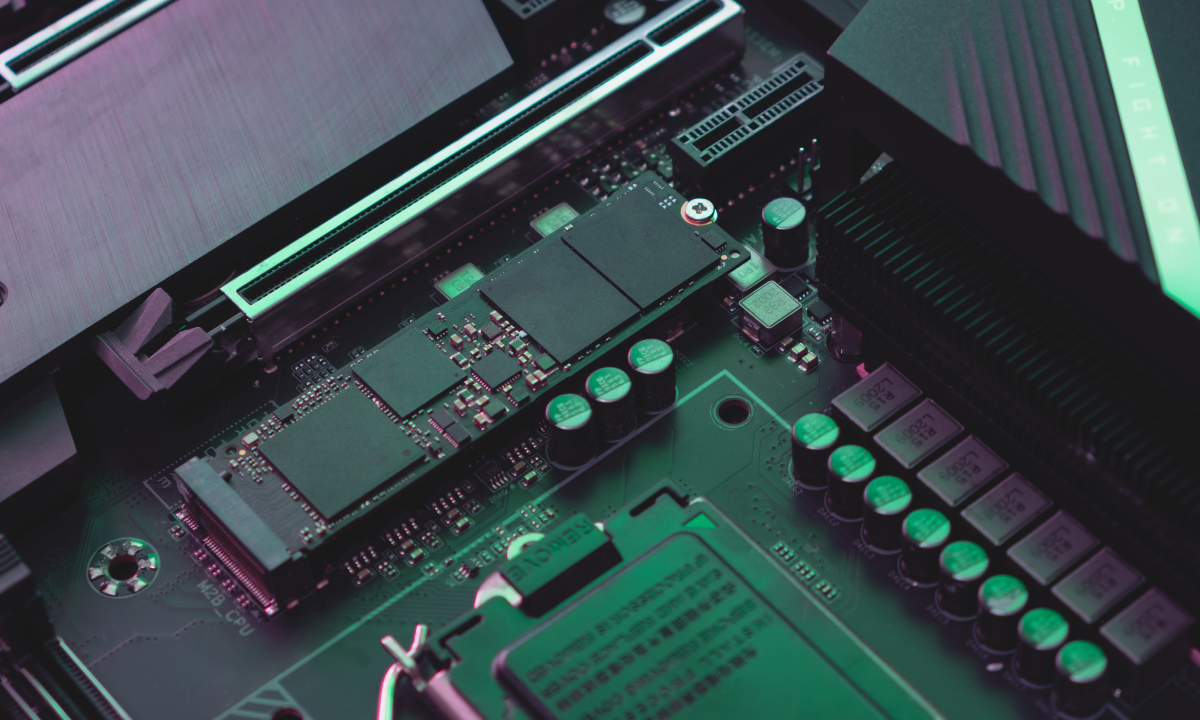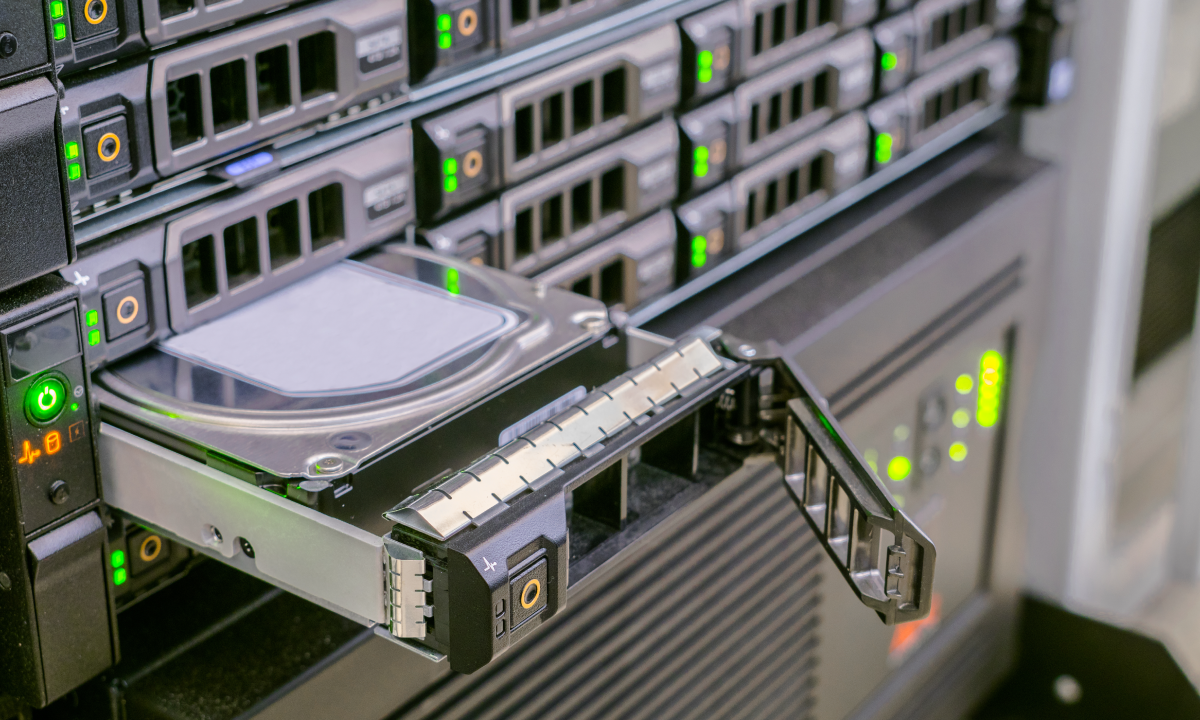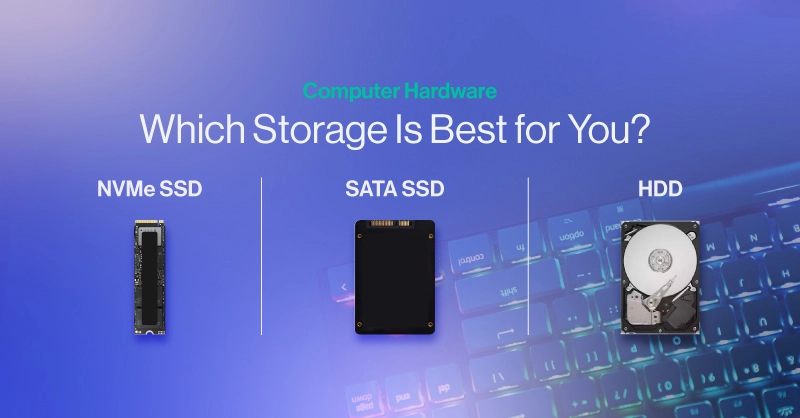Storing Data in the Right Places
Choosing the right storage type for your workstation or server is crucial for optimizing performance and efficiency. Determining which one is best suited for your needs can save you money and make your hardware work for you. We'll delve into the differences between NVMe SSDs, SATA SSDs, and SATA HDDs, exploring their unique features, advantages, and drawbacks to help you make an educated choice for your system.
Overview of NVMe, SATA SSD, and SATA HDD
Let's begin by providing an overview of NVMe SSDs, SATA SSDs, and SATA HDDs. Each storage type comes with its own set of characteristics, catering to different user requirements and preferences. Then we will compare them one by one.| NVMe SSD | SATA SSD | HDD | |
|---|---|---|---|
| Speed | PCIe 4.0: 7,500 MB/s PCIe 5.0: 14,000 MB/s | 550 MB/s | 160 MB/s |
| Best For | OS, gaming, active datasets, high-performance workloads | Legacy systems with hot-swap requirements | Cold storage, backups, archival data |
| Advantages | • Highest performance • Low latency • Direct PCIe connection | • Hot swappable (2.5") • Faster than HDD | • Lowest cost per GB • Hot swappable • Long-term data retention |
| Considerations | • Higher cost per GB • M.2 not hot swappable | • Largely obsolete • 13x slower than PCIe 4.0 NVMe | • Mechanical parts • Slower performance |
NVMe SSDs vs SATA SSDs
In 2025, use cases point overwhelmingly towards SSDs as the main storage option. SSDs deliver significantly faster speeds than HDDs, but not all SSDs are created equal.
NVMe will always be faster than SATA SSDs based on architecture alone. Although they both use NAND flash to store data, the way that data is transferred affects speed. SATA delivers data over a SATA controller, but data communication overhead bottlenecks transfer speeds at 550 MB/s.
NVMe SSDs bypass this limitation by connecting directly via the PCIe bus, delivering higher bandwidth and lower latency. With PCIe 5.0 now mainstream, NVMe SSDs deliver performance levels that were previously only available in enterprise data centers.

NVMe SSDs now come in multi-terabyte capacities at increasingly affordable prices. While still pricier per GB than HDDs, NVMe prices have dropped significantly, making them the default choice for most users. The performance advantages far outweigh the cost difference.
- Content creation, like 3D modeling, video editing, and rendering, can benefit from fast storage to import and export, read and write, and run intensive applications smoothly.
- Gamers who play graphics-intensive titles benefit from NVMe SSDs with lower wait times.
- Data-intensive applications like deep learning, simulation, and analytics need fast data transfer speeds to keep the processor and accelerators fed. NVMe SSDs

However, in the data center, SATA SSDs are still used in some legacy systems for their hot swap capabilities. While 2.5" and 3.5" U.2 NVMe SSD costs are high, some servers still use 2.5" SATA SSD drives to populate storage bays. That said, even enterprise environments are increasingly moving away from SATA SSDs in favor of NVMe solutions as costs continue to decrease and the performance benefits become more critical for modern workloads.
Are HDDs Still Used?
SSDs have a key limitation: write endurance. NAND flash memory can only be rewritten a finite number of times and can suffer from bit rot when data sits idle for extended periods. Infrequently accessed data risks corruption over time.
HDDs excel at long-term data retention and reliability. As storage has shifted toward SSDs, HDDs have found their niche in cold storage applications, backups, and archives in data centers. Today, HDDs are primarily used for archival purposes rather than active workloads.
Enterprise hard drives include enhanced reliability features for cold storage solutions. Home users benefit from low-cost, high-capacity HDDs in NAS systems, with RAID configurations providing redundancy against drive failures.

Choosing the Right Storage for Your Workload
Strategic data placement optimizes both performance and cost-efficiency:
- Cold storage: Use HDDs for infrequently accessed data like archives and backups
- Hot storage: Use NVMe SSDs for actively accessed data like working datasets and applications
HDDs vs SSD for Gaming
| HDDs for Gaming | NVMe SSDs for Gaming |
|---|---|
| Game Installs - The installs aren’t accessed often, only opened and run once. Most often will delete the install file, but if you plan to keep the install, place them on HDDs. | OS and Software - The Operating System and executable game files benefit from the fast performance of SSDs for better responsiveness |
| Media files - Cutscenes, audio tracks, and other media files can be stored on the HDD in a pinch. These are read sequentially, so the slower access of data won’t be a bottleneck issue for HDDs. However, placing them on the NVMe SSD decrease fetch time. | Open-world games - Games with large open environments benefit greatly when installed on NVMe SSDs. With DirectStorage API support now widely adopted, NVMe drives drastically reduce load times to new areas, textures, randomized events, and cutscenes, increasing responsiveness and immersion. |
| Backups and Game archives - Keeping save files that you want to go back to in the future can be stored on the hard drive. These save files can get large, especially for single-player games. | Competitive Multiplayer Games - Fast-paced competitive games like FPS titles and MOBAs benefit from NVMe SSDs for quicker match loading, faster respawns, and reduced stuttering when loading new assets mid-match, giving players a competitive edge. |
HDDs vs SSDs for Deep Learning
| HDDs for Deep Learning | NVMe SSDs for Deep Learning |
|---|---|
| Data Archiving and Backups - Large datasets not used for training or inference at the moment can be stored on HDDs as a cost-effective solution for long-term storage. However, if the data is to be used, moving to an SSD can drastically benefit training performance. | Training Data - Active datasets for LLM training should be stored on NVMe SSDs to minimize data loading bottlenecks and maximize GPU utilization. |
| Data Preprocessing - Preprocessed data, where datasets are cleaned, can be stored on HDDs first since this step is done before testing and training. | Model Checkpoints - Fast write speeds enable rapid checkpoint saves and quick experiment resumption during iterative model development. |
| Inference Data - Production inference servers benefit from NVMe storage for low-latency model loading. RAG systems especially require fast vector database queries. |
| Multimodal Training Data - Image, video, and audio datasets generate massive I/O demands. PCIe 5.0 NVMe drives prevent storage bottlenecks in data-intensive training pipelines. |
HDDs vs SSDs for Molecular Dynamics
| HDDs for Molecular Dynamics | SSDs for Molecular Dynamics |
|---|---|
| Data Archiving- Completed molecular dynamics simulations, large-scale datasets, and old research data that are not frequently accessed can be stored on HDDs for long-term archiving and data retention. | Active Simulation Data- Constant data access to datasets requires fast NVMe storage for simulations to complete faster since data is read and written in real time during trajectory generation and analysis. |
| Initial Input Files- Static molecular structure files, force field parameters, and initial configuration files that are read once at simulation startup can be stored on HDDs without impacting performance. | Trajectory Files- The continuously generated trajectory files should be written to NVMe SSDs to reduce performance bottlenecks and enable real-time analysis during long simulation runs. |
| Data Backup- Regular backups of critical research data and simulation results can be stored on HDDs to ensure data safety and recovery at a lower cost per terabyte. | Analysis and Visualization- Post-processing analysis scripts, coordinate files for molecular visualization, and data used for reconstructing 3D molecular models should be stored on NVMe SSDs for smooth, responsive rendering and fast computation. |
Conclusion
Choosing the right storage solution in 2025 comes down to understanding your specific needs and use cases. NVMe SSDs have become the clear choice for most computing tasks, offering exceptional performance that transforms everything from boot times to application responsiveness. If you can get all your high-access data on NVMe SSDs, we would recommend doing so.
Despite their slow nature, HDDs aren’t obsolete like SATA SSDs. They are now reserved fir archival storage where their reliability and cost-effectiveness shine.
- NVMe SSDs are the standard for operating systems, active workloads, and applications requiring high performance. PCIe 4.0 and 5.0 interfaces deliver speeds up to 14,000 MB/s.
- SATA SSDs are largely obsolete in 2025, with limited use in legacy enterprise systems requiring hot-swap 2.5" drives.
- SATA HDDs excel at cold storage, backups, and archival data where write endurance and long-term retention matter more than speed.
For most users, NVMe SSDs should handle active data and applications, while HDDs provide cost-effective bulk storage for infrequently accessed files. Whether you're building a gaming rig, a workstation for content creation, or a server for AI workloads, understanding these storage technologies empowers you to make informed decisions that maximize both performance and value.
At SabrePC, we are eager to help you find the right solution for your unique workloads. Contact us to learn more!



